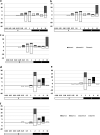Azole-Resistant Aspergillus fumigatus Clinical Isolate Screening in Azole-Containing Agar Plates (EUCAST E.Def 10.1): Low Impact of Plastic Trays Used and Poor Performance in Cryptic Species
- PMID: 34252311
- PMCID: PMC8291936
- DOI: 10.1128/AAC.00482-21
Azole-Resistant Aspergillus fumigatus Clinical Isolate Screening in Azole-Containing Agar Plates (EUCAST E.Def 10.1): Low Impact of Plastic Trays Used and Poor Performance in Cryptic Species
Abstract
Azole-containing agar is used in routine Aspergillus fumigatus azole resistance screening. We evaluated the impact of the type of plastic used to prepare in-house agar plates on the procedure's performance against A. fumigatus sensu stricto and cryptic species. A. fumigatus sensu stricto (n = 91) and cryptic species (n = 52) were classified as susceptible or resistant (EUCAST E.Def 9.3.2; clinical breakpoints v10). In-house azole-containing agar plates were prepared following EUCAST E.Def 10.1 on three types of multidish plates. We assessed the sensitivity, specificity, and agreement values of the agar plates to screen for azole resistance. Overall, sensitivity and specificity values of the agar screening method were 100% and 93.3%, respectively. The type of tray used did not affect these values. All isolates harboring TR34-L98H substitutions were classified as resistant to itraconazole and voriconazole by the agar method; however, false susceptibility (very major error) to posaconazole was not uncommon and happened in isolates with posaconazole MICs of 0.25 mg/liter. Isolates harboring G54R and TR46-Y121F-T289A substitutions were correctly classified by the agar method as itraconazole/posaconazole resistant and voriconazole resistant, respectively. False resistance (major error) occurred in isolates showing tiny fungal growth. Finally, agreements between both procedures against cryptic species were much lower. Azole-containing agar plates are a convenient and reliable tool to screen for resistance in A. fumigatus sensu stricto; the type of plastic tray used minimally affects the method. On the contrary, the performance against cryptic species is rather poor.
Keywords: Aspergillus fumigatus; EUCAST E.Def 10.1; agar plates; azoles; resistance.
Figures




References
-
- van der Linden JW, Arendrup MC, Warris A, Lagrou K, Pelloux H, Hauser PM, Chryssanthou E, Mellado E, Kidd SE, Tortorano AM, Dannaoui E, Gaustad P, Baddley JW, Uekotter A, Lass-Florl C, Klimko N, Moore CB, Denning DW, Pasqualotto AC, Kibbler C, Arikan-Akdagli S, Andes D, Meletiadis J, Naumiuk L, Nucci M, Melchers WJ, Verweij PE. 2015. Prospective multicenter international surveillance of azole resistance in Aspergillus fumigatus. Emerg Infect Dis 21:1041–1044. 10.3201/eid2106.140717. - DOI - PMC - PubMed
-
- Alastruey-Izquierdo A, Alcazar-Fuoli L, Rivero-Menendez O, Ayats J, Castro C, Garcia-Rodriguez J, Goterris-Bonet L, Ibanez-Martinez E, Linares-Sicilia MJ, Martin-Gomez MT, Martin-Mazuelos E, Pelaez T, Peman J, Rezusta A, Rojo S, Tejero R, Anza DV, Vinuelas J, Zapico MS, Cuenca-Estrella M. 2018. Molecular identification and susceptibility testing of molds isolated in a prospective surveillance of triazole resistance in Spain (FILPOP2 Study). Antimicrob Agents Chemother 62:e00358-18. 10.1128/AAC.00358-18. - DOI - PMC - PubMed
-
- Escribano P, Rodríguez-Sánchez B, Martín-Gómez MT, Ibáñez E, Rodríguez-Mayo M, Peláez T, García-Gómez de la Pedrosa E, Tejero-García R, Marimón JM, Reigadas E, Rezusta A, Labayru-Echeverría C, Pérez-Ayala A, Ayats J, Cobo F, Pazos C, López-Soria L, Alastruey-Izquierdo A, Muñoz P, Guinea J, on behalf of the ASPEIN study group. 2020. Azole resistance survey on clinical Aspergillus fumigatus isolates in Spain. Clin Microbiol Infect, in press. 10.1016/j.cmi.2020.09.042. - DOI - PubMed
-
- Lestrade PP, Bentvelsen RG, Schauwvlieghe A, Schalekamp S, van der Velden W, Kuiper EJ, van Paassen J, van der Hoven B, van der Lee HA, Melchers WJG, de Haan AF, van der Hoeven HL, Rijnders BJA, van der Beek MT, Verweij PE. 2019. Voriconazole resistance and mortality in invasive aspergillosis: a multicenter retrospective cohort study. Clin Infect Dis 68:1463–1471. 10.1093/cid/ciy859. - DOI - PubMed
Publication types
MeSH terms
Substances
LinkOut - more resources
Full Text Sources

